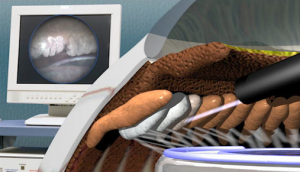Glaucoma is a leading cause of blindness. It is estimated that as few as 10% of those with the disease receive medical attention for it. While there is no cure, treatment can help preserve sight.
What Is Glaucoma?
Glaucoma is a disorder of the eye that damages the optic nerve. In most cases, the damage is caused by increases to the fluid filling the eye cavity. As pressure in the fluid (called inter-ocular pressure or IOP) builds, the fluid rests more heavily on the sensitive optic nerve connecting the eye with the brain, damaging this connection, resulting in loss of vision.
A Disease Without Symptoms
Most victims of glaucoma have no pain or other symptoms. Sufferers often only learn they have the disease when vision loss occurs. Because the vision loss is due to nerve damage, it is irreparable. Vision decreases at the periphery, with the result that those affected seem to see through a dark tunnel. As the optic nerve suffers increased damage, the remaining vision gradually fades.
Without treatment, total vision loss can happen in just a few years.
Early detection and treatment are critical to inhibiting the damage cause by high inter-ocular pressure.
New Findings Offer Hope
Currently the most common means of treating glaucoma are through medication or a combination of medication and surgical procedures.
Two procedures, endocyclophotocoagulation (ECP) and phacoemulsification, when used in tandem show promising signs of reducing IOP and the need for post-operative medications.
Phacoemulsification is a component of modern cataract surgery – the most common eye surgery performed today. In this procedure the clouded material of the eye’s lens (the cataract) is emulsified and removed before a new lens is put in its place.
ECP is a laser procedure often used to treat aggressive forms of glaucoma. It reduces IOP by treating the cells that produces the fluid.
The study recently published in the Journal of Cataract & Refractive Surgery noted that a combination of ECP and phacoemulsification “demonstrated a statistically significant reduction of both IOP and glaucoma medications compared to phacoemulsification alone.”
Both procedures are common with low instances of post-operative complications.
Glaucoma affects over two million Americans. Because so few who have the disease are aware they have it, the importance of early detection is critical to prevent permanent vision loss. Those over 40 are encouraged to have glaucoma screenings as a part of their regular eye checkups.
Dr. Silverman and the OCLI team have the latest state-of-the-art tools to keep your vision crystal clear. Schedule your appointment today.
